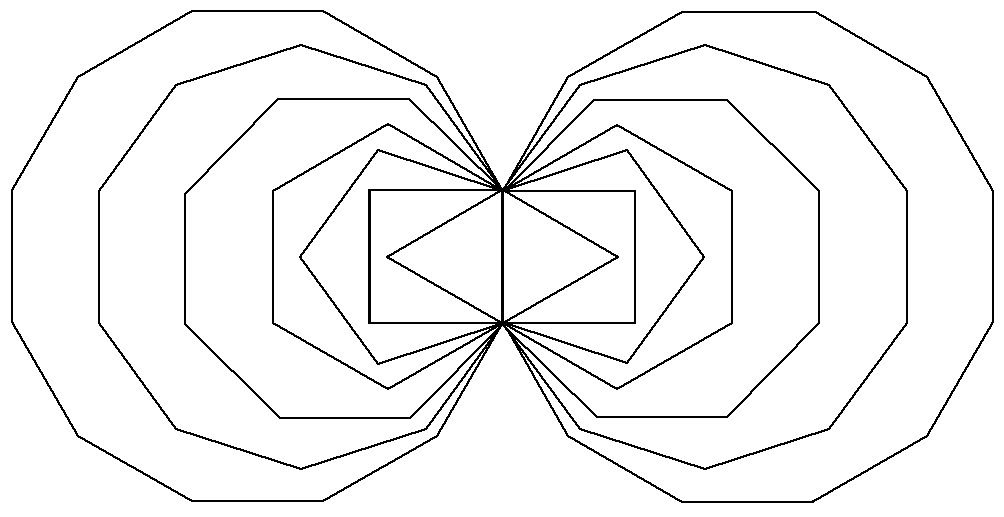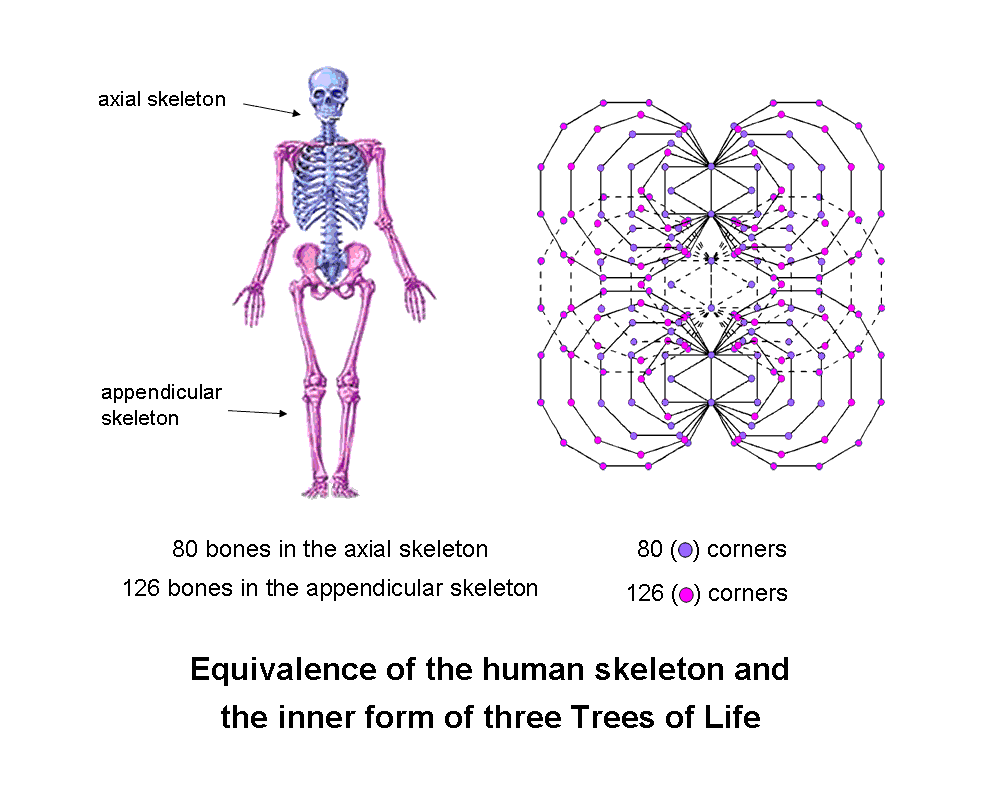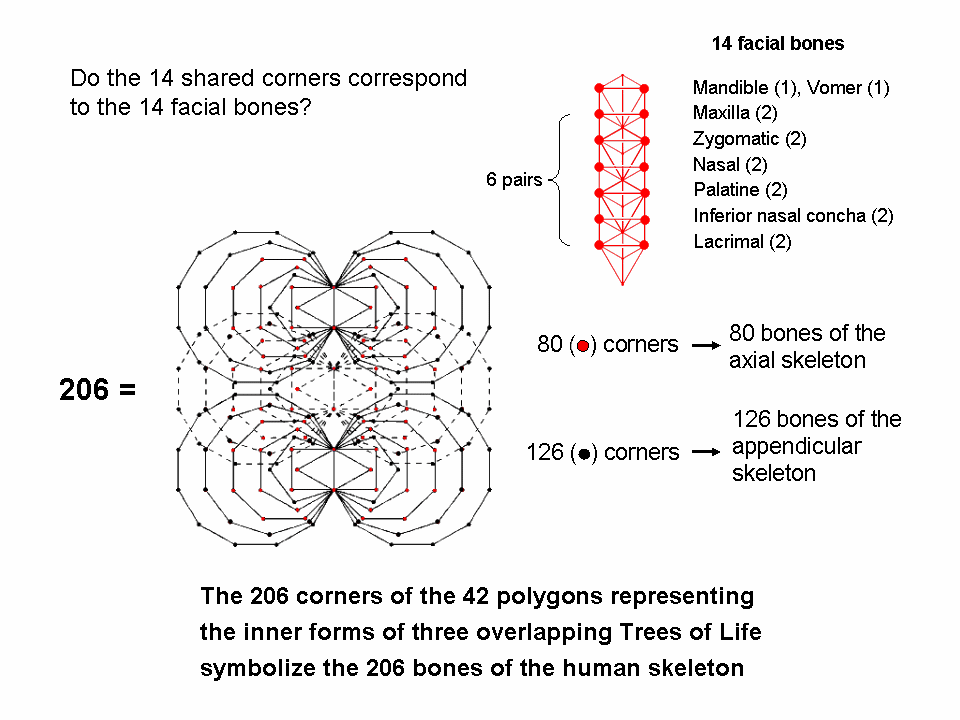
.png)
Figure 5. The inner Tree of Life.
Figure 6. The inner form of the 3-tree.
| << Previous 1... 2 3 [4] 5 6 ...15 Next >> |
|
|
.png) |
|
Figure 5. The inner Tree of Life. |
Figure 6. The inner form of the 3-tree. |
 |
It is possible (at least to some degree) to differentiate which polygons refer to the 80 bones of the axial skeleton and which refer to the 126 bones of the appendicular skeleton, as the following argument shows: as 80 is not exactly divisible by 3, but 126 is such, the 80 corners cannot belong to three similar, complete subsets of polygons unless the latter include the two hexagons. This is because the hexagons in adjacent Trees of Life share some of their corners, so that they are the only polygons whose numbers of corners for the complete set of 42 polygons is not a multiple of 3 (the six hexagons have 26 corners, 20 of which lie outside the three root edges; neither number is exactly divisible by 3). Hence, the set of polygons with 80 corners must include the hexagons. Figure 7 displays a possible assignment.* The 80 purple corners denoting bones in the axial skeleton are either corners of octagons and squares or corners of triangles and hexagons that coincide with Sephirothic emanations of the 3-tree. The 126 pink corners denote the 126 bones in the appendicular skeleton. It should be noted that this assignment is not the only possible one (see footnote). However, it does have the intuitively attractive feature that 14 of the 80 dots coincide with emanations of the 3-tree, which should be compared with the fact that there are 14 facial bones in the axial skeleton (see #3). This is reinforced by the following facts:
1. given that the set of 14 corners includes the top and bottom
of each hexagon, its remaining corners are either the endpoints of the three root edges or the
outer corners of the triangles; only the latter coincide with Sephiroth;
2. the 14 corners that are Sephiroth of the 3-tree comprise
six pairs, each pair being located on the left and right pillars, and a pair located at Chokmah
and Binah of the third Tree, which coincide with the topmost corners of the two hexagons
enfolded in this Tree. Compare this with the 14 facial bones comprising six pairs of bones:
maxillae, zygomatic, nasal, platine, inferior nasal concha & lacrimal, and two unpaired
bones: mandible & vomer (see YouTube video).
It is implausible that the existence of this 2×(6+1) pattern in
the 14 shared corners is a coincidence. Rather, it is simply a manifestation of the exact
isomorphism between the types of bones in the human skeleton and the types of corners in the 42
polygons making up the inner form of the 3-tree.
|
|
Figure 7 |
 |
Figure 8. The 14 corners (red dots in the 3-tree) of the triangles & hexagons that coincide with Sephirothic emanations of the 3-tree symbolize the 14 bones in the human face. The lowest 6 pairs of corners correspond to the 6 pairs of facial bones and the highest pair of corners correspond to the two unpaired facial bones. |
where 8 = 4(1) + 2(2), 6 = 3(2), 1 = 1(1), 26 = 26(1) and 25 = 1(1) + 12(2), the 66 bones do contain two single bones from the various groups in the axial skeleton that occur on their own, namely, the hyoid and sternum, as well as two pairs of bones that likewise occur on their own, namely, the parietal and temporal bones in the cranium. Because of this distinction, there is nothing ad hoc in their assignment to the endpoints of the three root edges.
* If the intuitively reasonable assumption is made that the bones corresponding to the two endpoints of each root edge must belong to the axial skeleton, the only alternative to the illustrated assignment can be deduced as follows: because they include the hexagons, the 80 corners of the 42 polygons are given by
80 = 3×26 + 2,
where 26 is the number of corners per set of 14 polygons. If these include the root edge, 26 = 8 + 18, where the former number is the number of corners of the two hexagons per set and the latter is the number of corners of the other set of polygons outside the root edge (nine in each set of polygons and nine in their mirror images). The numbers of corners of each polygon outside the root edge are:
| Polygon |
triangle |
square |
pentagon |
hexagon |
octagon |
decagon |
dodecagon |
| Numbers of corners outside root edge |
1 |
2 |
3 |
4 |
6 |
8 |
10 |
Either:
1. a triangle & decagon,
2. a pentagon & octagon,
3. a triangle, square & octagon
have nine such corners. Combination 2 is excluded if the intuitively reasonable assumption is made
that corners shared with the outer Tree of Life ought to denote bones of the axial skeleton rather than bones
of the appendicular skeleton, for the corner of the triangle that lies outside its root edge is just such a
shared corner, but none of the corners of the pentagon and octagon are shared. We conclude that there are only
two schemes of correspondence between corners and bones of the axial skeleton that are intuitively plausible. Its
80 bones correspond to the 80 corners of the triangles, hexagons and
either the squares & octagons or the decagons. Figure 8 depicts the former scheme of correspondence.